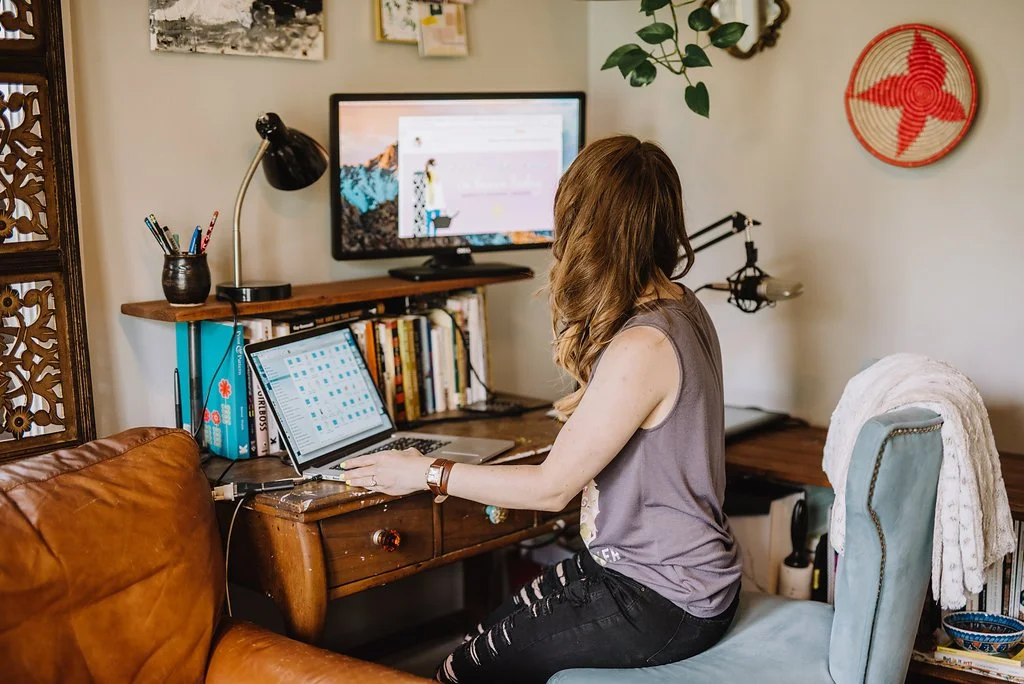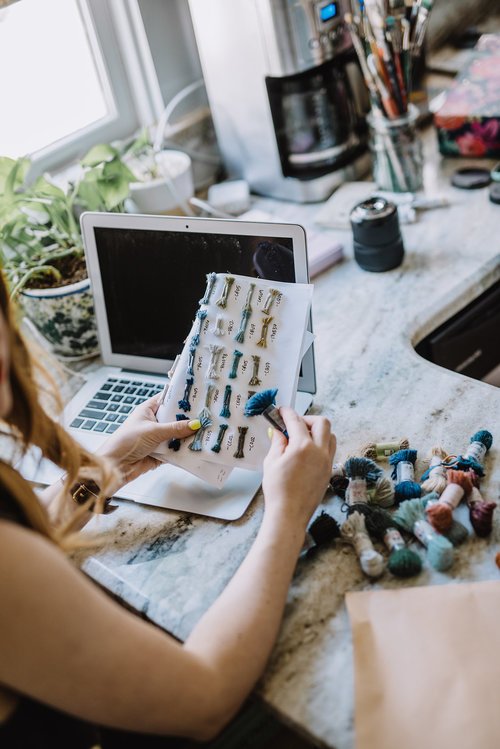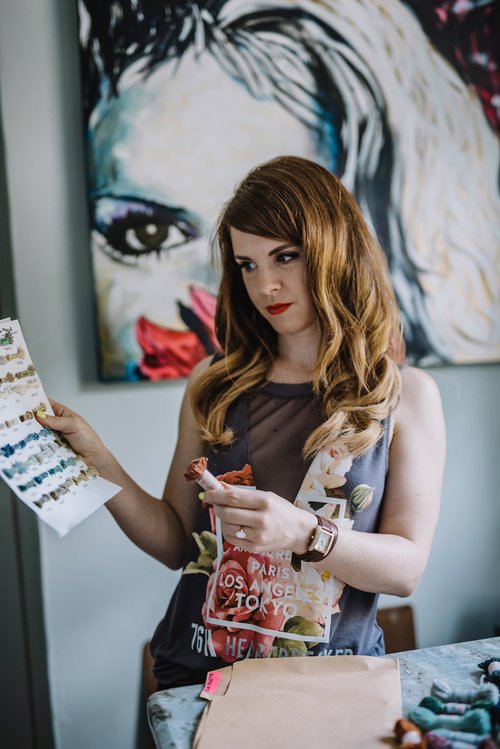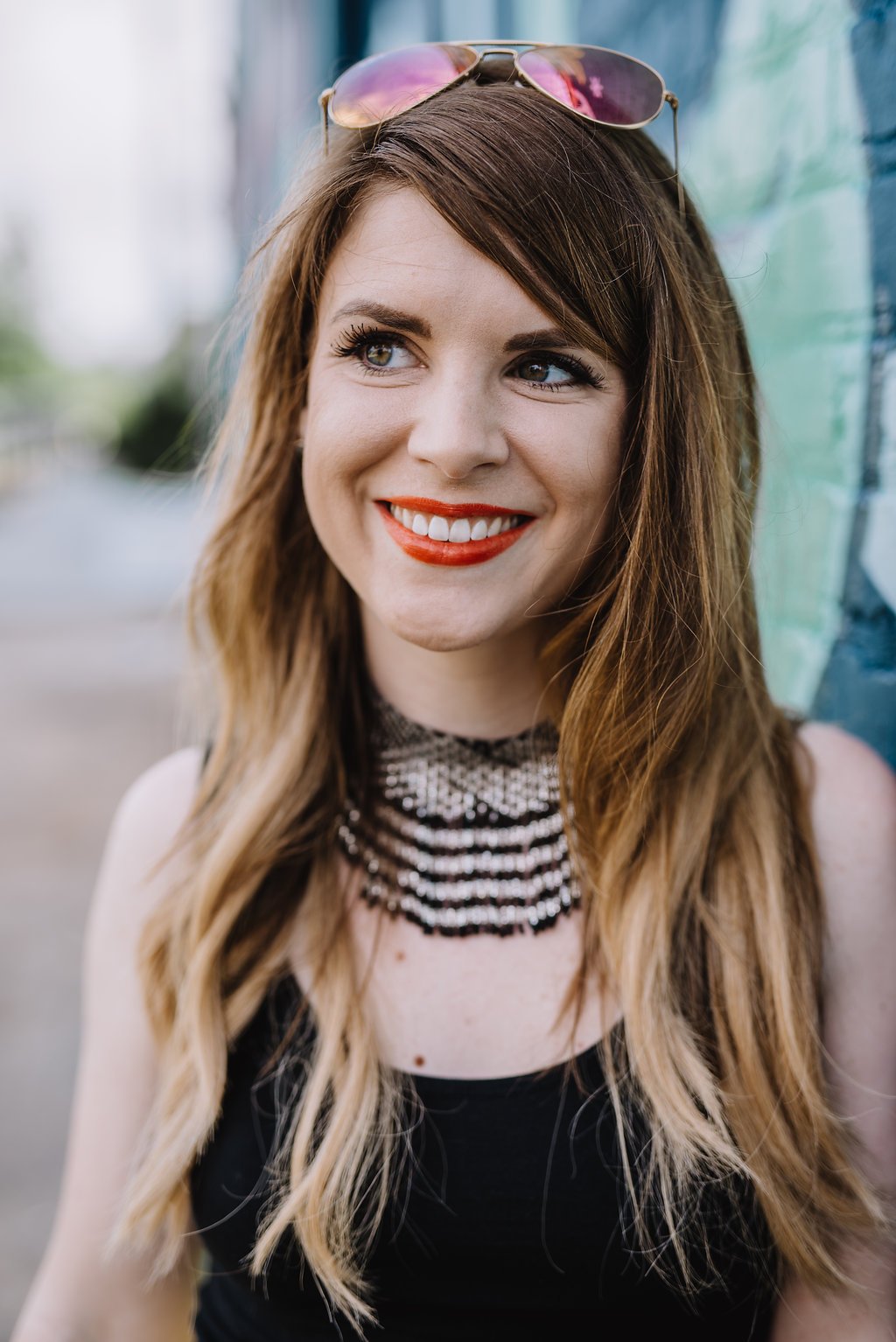So You Want to Become a Textile Designer? 5 Easy Tips for Getting Started →
Become a Textile Designer Today
With my 5 easy tips for getting started!
Have you ever spent time swooning over fabric patterns or patterns in clothes? Or maybe you bought something that didn't really fit you just because you like the textiles.
Then you may be a textile designer at heart! It's a job that suits creative thinkers who love fashion and being experimental with art techniques.
Designers from William Morris to Cath Kidston have produced amazing work that adorns walls, clothes, bags, and furniture across the world.
But how do you get into the field? Read on to discover the 5 steps you can take to become a textile designer.
WHAT DOES A TEXTILE DESIGNER DO?
Textile designers create the patterns for fabric or other soft woven surfaces. We often get mistaken for fashion designers, who design clothing and other forms of apparel, or interior designers, who design rooms and spaces by styling products, choosing paint colors, and bringing the entire vision to life.
That said, some designers specialize in an end product when they're designing fabric or textiles. So you might choose to create designs for kids or women's fashion. In my case, I am a textile designer who specializing in designing rugs, pillows, and other soft goods in the home decor industry.
Many textile designers major in textile design, but others study graphic design or surface design. However, with online courses booming you don't necessarily need a degree from a 4 year institution especially if you must take out a scary high number of student loans. To get your feet wet, I suggest watching YouTube videos or taking an online course and uploading your work to print-on-demand fabric websites.
The average salary for a Textile Designer is $51,791 per year in the United States. In the UK, salaries start at 15,000 and can top 40,000 with more experience.
So now we know what a textile designer does, let's look at the 5 steps to becoming one.
WATCH MY YOUTUBE VIDEO
HOW TO BECOME A TEXTILE DESIGNER
1 | LEARN THE BASICS OF FABRIC DESIGN
Being a textile designer doesn't just mean you create nice patterns and add it to fabric. You need to learn how to create designs in the first place. That means learning to understand client briefs and work with other creatives, like design teams. You’ll also need the fundamental software skills in Illustrator and Photoshop and basic drawing skills.
You'll also need to learn about color theory, textures, composition, pattern genres and other elements of textile design like learning the characteristics of different fibers such as cotton, wool, nylon, and different types of polyester.
Good textile designers are excellent researchers and collect examples of interesting design. Compiling a scrapbook of cool fabrics, unusual patterns or even eye-catching lettering is a great way to start gathering inspiration.
You’ll also need to research trends online and at brick-and-mortar retailers. I recommend starting on Pinterest and start collecting images on boards. From there, you’ll want to bookmark different blogs you follow, perhaps sign up on Bloglovin, and collect images from hot Instagram accounts.
2 | LEARN HOW TEXTILES WORK
Next, you'll need to know how textiles actually work. Not all textile designers have degrees in textile design.
But they'll often have a background in something like art or surface design. This gives them a solid foundation into applying what they know about color, composition, and style to textiles.
A textile designer needs to know how textiles 'wear', hang, or last when they're turned into other items. The weight and even its flammability affect the final product. Hint: All U.S. products must adhere to California flammability laws.
You'll also need to experiment to learn how fabrics hold color after dying. And embellishment is a great way to add an extra level to a design.
Textile designers experiment with techniques like;
screen printing
transfer printing
digital printing
batik
marbling
block printing
weaving
They all affect how a pattern will appear on the finished fabric. Knowing which technique suits which end result helps when you're unraveling a client brief.
Knowing how to sew isn't essential but it does mean you can mock up sample textiles into products to see how they work in three dimension. Being able to create client presentations is also essential, so you can communicate through sketches, illustrations, or verbal means.
Textile designers should also know the different characteristics of:
wool
cotton
P.E.T.
polypropylene
nylon
polyester
viscose
silk
olefin
jute
3 | CREATE A PORTFOLIO
Employers look for strong portfolios from the designers they hire. You need to show your competency in the industry you’re applying to work in as well as your original design ideas.
Once you have a job in the industry, you'll also add designs to help win contracts.
Most designers have both a physical and a digital portfolio.
You'll need at least 20 designs for a physical portfolio, and 30 for a digital one. Add notes to explain the context for each design and show your creative process. Employers LOVE to see how your brain works through a creative problem and arrives at a beautiful solution.
You can explain which techniques you used and why. Tell any stories behind the designs to explain your design choices.
Where possible, have different pages available so you can tailor your portfolio depending on who needs to see it.
Develop a form of personal branding to tie your portfolio together. This helps the viewer to see yours as separate from the others they're looking at. It can also help highlight your specific skills or background.
Use your personal branding across your website, social media, business cards, or other materials. Contact me if you'd like a portrait logo for your branding. :)
4 | START NETWORKING
As with most industries, your success will depend on your ability to make connections. If you have a design background, think back to your classmates from college.
Get in touch where you can and see if you can share contacts in the industry. Check out more professional organizations like the American Textile Manufacturers Institute for their networking opportunities or simply go to networking events for young professionals in your city.
Make use of social media platforms like Instagram to showcase your work. But set yourself up on LinkedIn and connect with industry professionals.
Write articles about textile design to demonstrate your knowledge and share these on your social media platforms. Even approaching low-level design podcasts for interview opportunities can be a way to get your name out there.
Follow designers and other industry professionals you admire. Ask them for their feedback on sites like Dribbble. - designers are often more accessible on social media than they are by email.
And don't be afraid to ask for work placements or internships.
In the meantime, partner with fashion design students to create original fashions from your textiles. It's a great way to build your portfolio and show you can work within the industry.
5 | KEEP YOUR SKILLS SHARP
Choosing to work in textile design means committing to keeping your skills up to date.
You'll need to follow trends and even better, learn to predict them. Websites like WGSN can help you keep updated with where your industry might go. This means your designs will always be fresh and ahead of the curve.
You'll also need to learn new techniques or methods. New technology will come along that can help you to create new designs or speed up your process.
As an example, I created this watercolor geometric pattern which taps into popular handmade and geometric designs.
Even learning about textiles in earlier periods or visiting galleries to see patterns from other cultures is a great way to maintain your self-education.
SKETCHBOOKING YOUR STYLE
Join the FREE workshop to learn how to develop your own Art Style!









